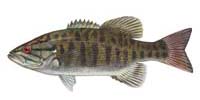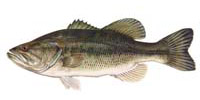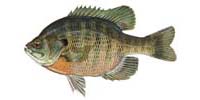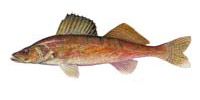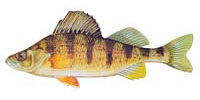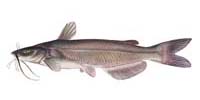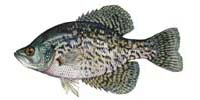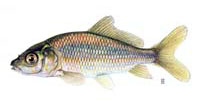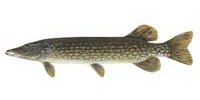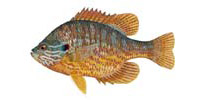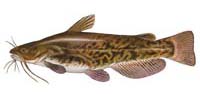Known as “Nature’s Fish Hatchery,” Black Lake is the largest of the Indian River lakes. It is truly an anglers paradise, offering a diversity of fish life and habitats. Black Lake offers ideal fish habitats including shoals, bays, sandbars, weed beds, island drop-offs and rocky points where anglers can target a variety of fish species from pike to panfish.
Blake Lake has a healthy population of panfish, and is especially well known for it abundant crappie, bluegill and yellow perch. Panfish can be fished year round and are on the large size—10 to 12 inches. Largemouth and smallmouth bass are found throughout the lake and average between 3-5 pounds. Walleye, northern pike, and muskellunge are three other common sport fish found in here.
If you have a motorboat, you can get out on the water using the lake’s concrete boat ramp. There is no limit on horsepower at Black Lake. If you prefer fishing from a non-motorized boat, you can launch a canoe, kayak, or car topper at several locations around the lake. There are also plenty of good spots along the 60 mile shoreline to wet your line.
Black Lake Fish Species
The most common sport fish on Black Lake include crappie, perch, blue gill, bass, walleye, northern pike, but you many encounter any of the species shown below.
Bass
Bass season gets underway the 3rd Saturday in June, and largemouths can be found in any of Black Lake’s numerous shallow-water bays. Largemouths will take a variety of baits and lures, but the number one bait for getting bass to bite is a good ol’ soft plastic worm. Other productive baits include live crabs, crankbaits, spinnerbaits and in-line spinners.
Sometimes simpler is better, and fishing a good ol’ Mepps Aglia plain spinner. Mike the ‘Outdoor Detective’ reports out bass fishing his three fishing companions two to one using the Mepps Aglia #2 (1/6 oz), #3 (1/4 oz), #4 (1/3oz) and #5 (1/2 oz), using almost exclusively Mepps gold blade, silver blade and copper blade. Mike also fished the fire tiger blade, but nothing was able to compete with the gold, silver and copper blades. The Mepps Aglia spinner even out performed spinnerbaits.
As summer heats up, bass fishing cools down. During the summer you’ll most often find bass near heavy weed cover, deep water adjacent to shoals, drop-offs at island edges, and rocky points. Targeting bass during the early morning or evening is most productive.
Smallmouth bass are also abundant on Black Lake. During the warmer months smallmouth bass congregate near any structure toward the middle of the lake—especially at the southern end. During the evening, and under low-light conditions, smallies will move in to the shallows to forage. Smallmouth bass on Black Lake will readily take worms, crankbaits, and lures that mimic crayfish.
As fall approaches, and water temps begin to drop, fishing for both largemouths and smallmouths becomes more productive. During the fall, one of the best baits for targeting bass are live minnows, even moreso than live crabs. And shallow-running crankbaits tend to be a bit more effective than deep divers.
Panfish
While a lot of anglers come for the bass fishing, panfish is the number one catch on on Black Lake. The panfish fishing on Black Lake tends to be productive year in and year out. And there is such a variety of panfish that over half of anglers on the lake come specifically to try their hand at catching panfish.
Bluegill
Bluegill on Black Lake are plentiful and easy to catch. You’ll find the largest concentrations of bluegill in the shallow bays and marshy areas with heavy vegetation during early spring throuh June. As spring turns into summer, a lot bluegill begin holding in slightly deeper water adjacent to structure such as rock pile and weedlines. Angler can target bluegill year round, though fall tends to be a bit slow.
Yellow Perch
Second only to bluegill, yellow perch is a popular target for anglers arriving at Black Lake. You can find perch just about anywhere on the lake you decide to wet your line. Small perch on Black Lake are abundant, so if you want to find the jumbos keep moving around until you locate a school of larger perch. One of the most common places you’ll find perch holding is just off the rocky points throughout Black Lake.
Crappie
Black crappie is the most common panfish found in Black Lake. During early spring between April and May, most of the marshy bays around the lake are chock full of crappie. As June arrives, and waters warm, crappie move out of the bays and disperse throughout the lake. During later fall, one of the most productive spots to target crappie is on the shoals and rock piles located in the middle of the lake.
Northern Pike
Northern Pike aren’t a big draw to Black Lake, but if you’re interested in snagging a pike or two you’ll find plenty here. When pike season opens early May you’ll find pike holding in the shallow bays near new vegetation and weed beds. Fish along the weed edges, or over the top of the weeds back toward the edges, with spoons, topwaters, spinnerbaits and in-line spinners. As spring turns into summer, Northern Pike disperse to deeper water where weedbeds have now reached their full height. By late fall, pike can be found throughout the lake.
Larger pike often hold in the deeper parts of Black Lake and have a preference for live bait, but they’ll also take spinners, spinerbaits and plugs. Drifting a 4-6 inch shiner or sucker fish at a depth of 10 to 15 feet is sure to get a hookup. Vertical jigging with a 4 inch tube jig is another productive way to target larger pike. During the winter, fishing a few large shiners through the ice on tip-ups is a sure fire way to catch larger pike. Most anglers report pike fishing to be best during the month of December.
Walleye
Most walleye are caught by anglers incidentally by anglers while fishing weed beds for bass or pike. They’re hard to target specifically. Basic methods for fishing walleye include trolling crawler harnesses and crankbaits, jigging minnows, or slip bobbers. Points, shoals, widge edges and boulders are all favorite walleye hangouts.
Early in the season is by far the best time of year to target walleye. By summer walleye have feasted on small perch and aren’t as willing to take bait or a lure. Crankbaits and spinners fished along the weed edges and jigs tipped with gulp worm are two methods anglers report effective for targeting walleye on Black Lake.
Night fishing for walleye in the shallows can be productive, but it’s a bit challenging on a lake with so many rocks and weeds—especially if you’re trolling. I’d avoid trolling at night and try fishing a slip bobber rig with a juicy nightcrawler or bass minnow in about 5-8 feet of water.
Using a good fish finder is your best bet for catching walleye on Black Lake. Ride around and check likely holding spots with your sonar until you identify where walleye are holding… and then cast your line. Pick up a ‘hotmap’ at any local tackle shop in the area to help you identify areas of interest.
Catfish
There are two types of catfish you’ll find in Black Lake: channel cats and brown bullheads. Early spring is hotbed of bullhead activity and trophy channel cats are pulled out of Black Lake year round. The best time of year to target either species is during May and early June when they congregate in several of the bays (e.g. Lower Deep Bay) to spawn. During the spring hungry catfish will take any number of baits including nightcrawlers, minnows, chicken liever, crabs, leeches and even artificial lures such deep diving crankbaits and jigs.
As temperatures warm moving into summer catfish can be found foraging along the bottom at depths anywhere from 5 to 15 feet. Key to catching catfish is staying on the bottom. Still fishing is one of the best ways to target foraging catfish. Bullheads are easiest to catch a night when they’re most active, or on overcast days. Put a good hook with a nice size worm on the the bottom and let it sit. With a little patience you’ll reel in some lunkers.
Favorite Spots
It’s difficult to pinpoint any one ‘hotspot’ of fish activity. Fish don’t hold in one place and water conditions change. Targeting specific habitats for specific fish species (as identified above) is your best bet at increasing your catch rate and having an all around enjoyable fishing experience.
Notwithstanding, there are few areas on Black Lake that tend to produce consistently. I don’t know if you’d call these hotspots, but they’re certainly productive. Overall, I have found the south end of the lake to be most productive, probably because of all the diverse habitat and structure.
A few of my favorite fishing spots that may be worth trying.
- Lower Big Bay – Lots of bass activity here during the spring
- Upper Big Bay – located south of Lower Big Bay. Another good bass fishing spot.
- Mitchell – Have had a lot of success here for panfish and bass.
- Orchard Bay
- Upper Deep Bay – another hotbed of fish activity
- Rollway Bay – Wet your line just southwest of Bay Island
There are so many good fishing spots on the south end of Black Lake it’s not fair to say one spot is necessarily better than another. That’s the great part of fishing Black Lake. Always a new fishing adventure and you’ll find a new hot spot every time you visit.
Note: Black Lake continues to be one of the premier fishing lakes in Upstate New York, but it will only continue to be this way if anglers practice responsible fishing. In recent years reports of anglers killing many of the bigger spawners may be leading to a decrease in bass populations. Respect bass beds and bass spawn. Practice catch and release when it makes sense. Preserve Black Lake for generations of anglers to come.
Black Lake Boat Ramps
The following boat ramps provide access to Black Lake.
Black Lake State Boat Launch
26 1st St, Hammond, NY 13646
Directions
Black Lake Waterway Access
6 Off Cir, Hammond, NY 13646
Directions


